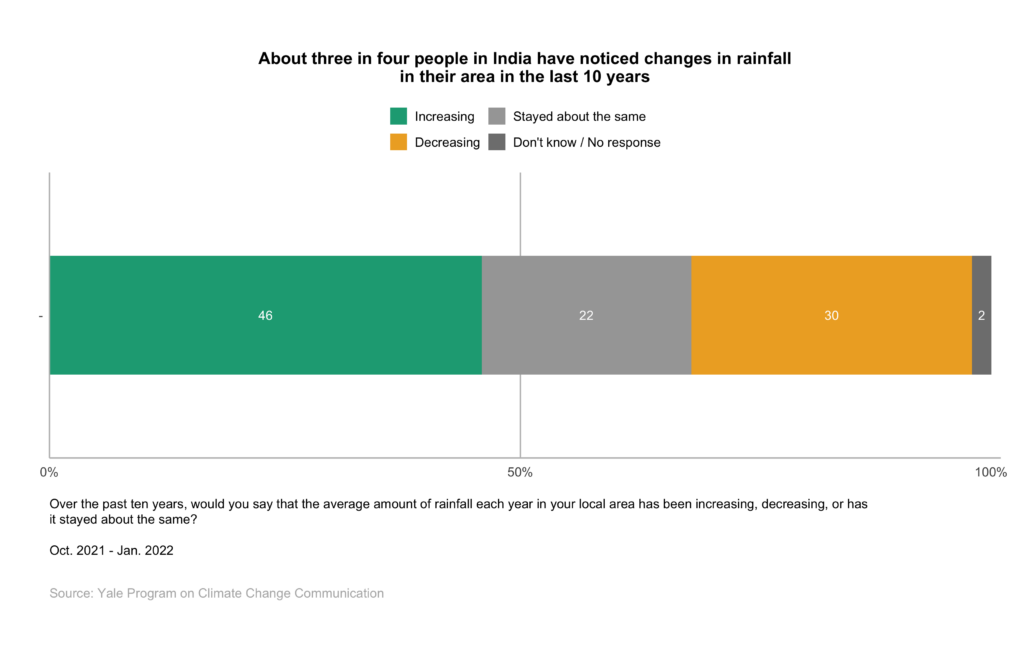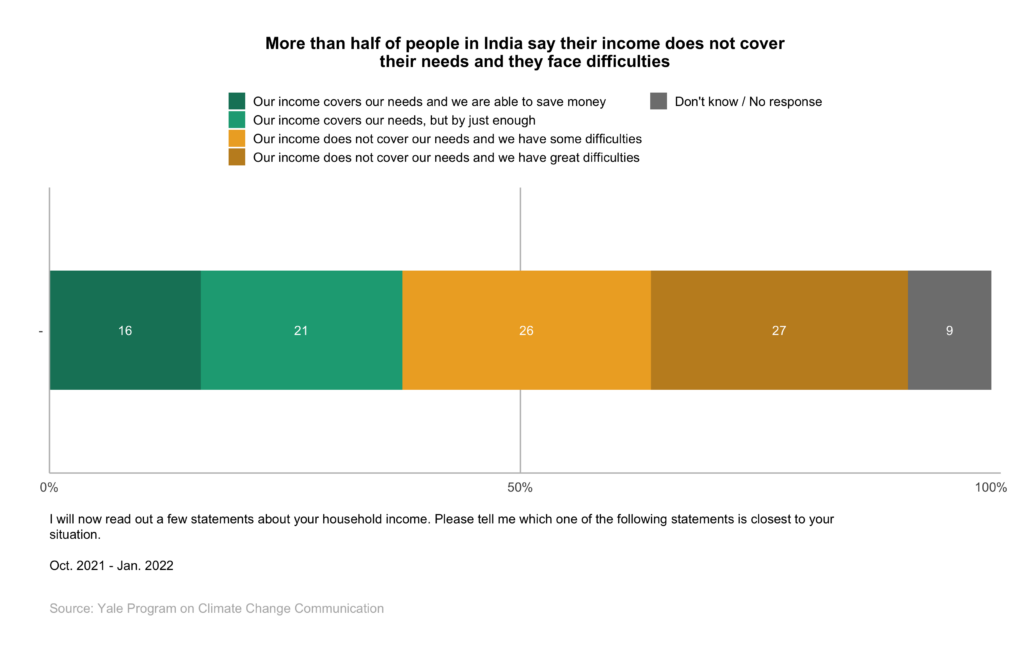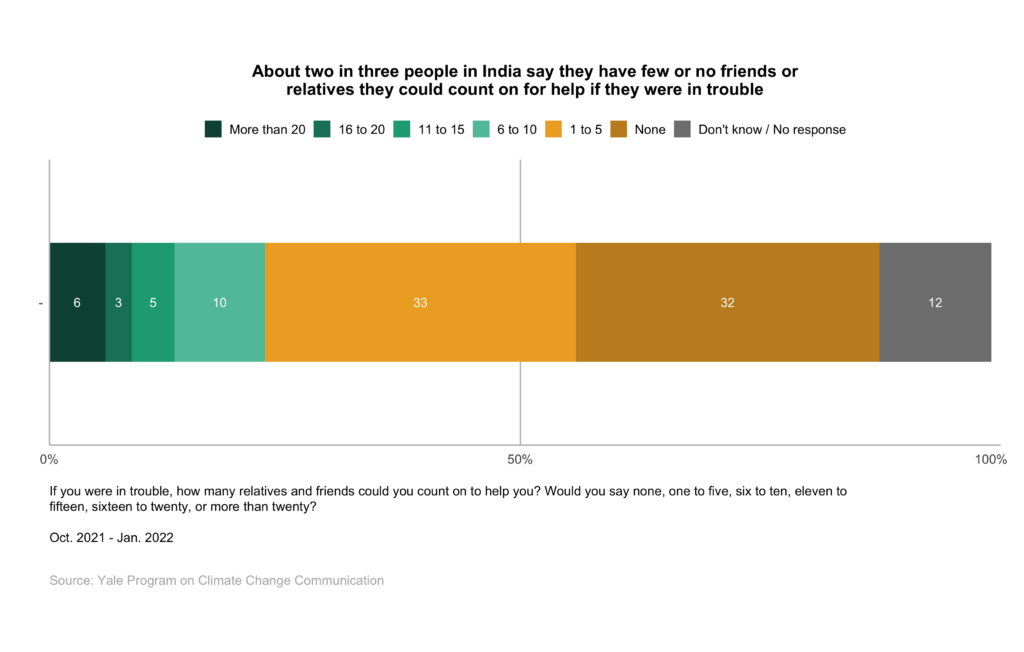Report · Oct 19, 2022
Climate Change in the Indian Mind, 2022
By Anthony Leiserowitz, Jagadish Thaker, Jennifer Carman, Liz Neyens, Seth Rosenthal, Yashwant Deshmukh, Gaura Shukla, Jennifer Marlon, Arunima Sircar and Stella Sekoff
Filed under: Behaviors & Actions and Beliefs & Attitudes
6. Local Weather Events: Observations, Vulnerabilities, and Resilience
6.1 About three in four people in India have noticed changes in rainfall in their area in the last 10 years.
India is geographically diverse, and different parts of the country experience different patterns of heat, rainfall, and extreme weather. A large majority of people in India say they have observed changes in local climate and weather patterns in their own area. A future analysis will examine the geographic variation in responses to these questions.
Nationally, more than four in ten people in India (46%) say the average amount of rainfall in their local area has increased over the past 10 years, while 30% say it has decreased, and 22% say it has stayed about the same.
Compared to 2011, a higher percentage of people in India now say the average amount of rainfall in their local area has increased over the past 10 years (+12 percentage points), while a smaller percentage say it has decreased (-16). 6.2 About one in four people in India say the monsoon in their local area has become less predictable compared to the past.
6.2 About one in four people in India say the monsoon in their local area has become less predictable compared to the past.
More than half of people in India say they have observed changes in the predictability of the monsoon in their local area. This includes about four in ten (41%) who say the monsoon has become more predictable compared to the past and 27% who say it has become less predictable. About one in four (26%) say it has not changed.
Compared to 2011, a higher percentage of people in India now say the monsoon has become more predictable in their area (+17 percentage points), while a smaller percentage say it has become less predictable (-11), and about the same percentage say it has not changed. 6.3 Most people in India say hot days have become more frequent in their local area.
6.3 Most people in India say hot days have become more frequent in their local area.
A majority of people in India (56%) say hot days have become more frequent in their local area, while 18% say they have become less frequent, and 23% say there has been no change.
Fewer (28%) say that droughts have become more frequent, while 30% say droughts have become less frequent, and 32% say they have not changed. Similarly, one in four say that severe storms and floods (both 25%) have become more frequent, while more say they have become less frequent (severe storms, 31%; floods, 28%) or have not changed (severe storms, 34%; floods, 30%).
Compared to 2011, a higher percentage of people in India now say most of these events have become more frequent in their local area (floods, +11 percentage points; droughts, +8; severe storms, +4). 6.4 A majority of people in India say it would take them several months or more to recover from a severe drought or flood.
6.4 A majority of people in India say it would take them several months or more to recover from a severe drought or flood.
About three in four people in India (74%) say it would take their household several months or more to recover from a severe drought, and more than six in ten (63%) say it would take several months or more to recover from a severe flood. This includes about one in four respondents who say it would take them several years to recover from a severe drought (28%) or a severe flood (26%).
Compared to 2011, a higher percentage of people in India say it would take their household several months or more to recover from a severe drought (+10 percentage points), while the percentage who say it would take that long to recover from a severe flood is about the same. 6.5 More than half of people in India say their income does not cover their needs and they face difficulties.
6.5 More than half of people in India say their income does not cover their needs and they face difficulties.
Only 16% of people in India say their household income covers their needs and they are able to save money, and 21% say their income covers their needs, but by just enough. More than half of people in India say their income does not cover their needs and that they either have “some difficulties” (26%) or “great difficulties” (27%).
The percentage of people in India who say their household is financially stable is lower than in 2011: a lower percentage say their income covers needs and are able to save money (-14 percentage points); or their income covers needs, but by just enough (-16). In contrast, the percentage who say they face financial hardship is higher than in 2011: a higher percentage say their income does not cover needs and they have some difficulties (+10 percentage points); or their income does not cover needs and they have great difficulties (+17). It is possible these results partly reflect the national context during the COVID-19 pandemic. 6.6 About two in three people in India say they have few or no friends or relatives they could count on for help if they were in trouble.
6.6 About two in three people in India say they have few or no friends or relatives they could count on for help if they were in trouble.
When asked how many relatives and friends they could count on if they were in trouble and needed help, about two-thirds of people in India say either “none” (32%) or “1 to 5” (33%). Only about one in four say they have either “6 to 10” (10%) or more than 10 (13%) friends or relatives they could count on to help them.
The percentage of respondents who say that they do not have any friends or relatives they could count on to help if they were in trouble is higher by a small margin than in 2011 (+4 percentage points), while the other responses have not changed significantly. It is possible these results partly reflect the national context during the COVID-19 pandemic.